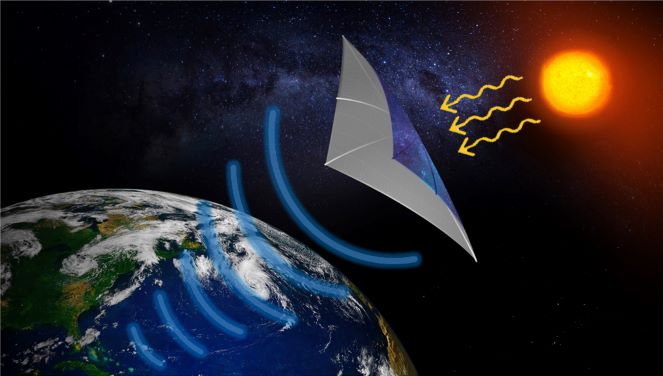Japanese satellite will beam solar power to Earth in 2025

United States
Breaking News:
Maple Leafs star Auston Matthews to miss Game 6 of first-round series against Bruins
Trump trial live updates: ‘What have we done?’ Stormy Daniels’ lawyer texted on election night
Two more women file suits alleging sexual assault by Newfoundland police officer
Demetrious Johnson aspires to ‘box a legend of the sport,’ not a fellow MMA fighter
Washington DC
Thursday, May 2, 2024



LONDON — Japan is on track to beam solar power from space to Earth next year, two years after a similar feat was achieved by U.S. engineers. The development marks an important step toward a possible space-based solar power station that could help wean the world off fossil fuels amid the intensifying battle against climate change.
Speaking at the International Conference on Energy from Space, held here this week, Koichi Ijichi, an adviser at the Japanese research institute Japan Space Systems, outlined Japan’s road map toward an orbital demonstration of a miniature space-based solar power plant that will wirelessly transmit energy from low Earth orbit to Earth.
“It will be a small satellite, about 180 kilograms [400 pounds], that will transmit about 1 kilowatt of power from the altitude of 400 kilometers [250 miles],” Ijichi said at the conference.
Related: Space-based solar power may be one step closer to reality, thanks to this key test (video)
One kilowatt is about the amount of power needed to run a household appliance, such as a small dishwasher, for about an hour, depending on its size. Therefore, the demonstration is nowhere near the scale required for commercial use.
The spacecraft will use a 22-square-foot (2 square meters) onboard photovoltaic panel to charge a battery. The accumulated energy will then be transformed into microwaves and beamed toward a receiving antenna on Earth. Because the spacecraft travels very fast — around 17,400 mph (28,000 km/h) — antenna elements will have to be spread over a distance of about 25 miles (40 km), spaced 3 miles (5 km) apart, to allow enough energy to be transmitted.
“The transmission will take only a few minutes,” Ijichi said. “But once the battery is empty, it will take several days to recharge.”
Breaking space news, the latest updates on rocket launches, skywatching events and more!
The mission, part of a project called OHISAMA (Japanese for “sun”), is on track for launch in 2025. The researchers have already demonstrated wireless transmission of solar power on the ground from a stationary source, and they plan to conduct a transmission from an aircraft in December. The aircraft will be fitted with an identical photovoltaic panel as will be flown on the spacecraft and will beam down power over a distance of 3 to 4 miles (5 to 7 km), according to Ijichi.
Space-based solar power generation, first described in 1968 by former Apollo engineer
Peter Glaser, has been considered science fiction. Although theoretically feasible, the technology has been seen as impractical and too costly, as it requires enormous structures to be assembled in orbit to produce the required power output.
But according to the experts speaking at the conference, that situation has changed as a result of recent technological advances and the urgency to decarbonize the world’s power supply to thwart climate change.
Unlike most renewable power generation technologies used on Earth, including solar power and wind energy, space-based solar power could be available constantly, as it would not depend on weather and the time of the day. Currently, nuclear power plants or gas- and coal-fired power stations are used to cover demand when the wind stops blowing or after sunset. Improvements in technology could help partially solve the problem in the future. But some pieces of the puzzle are still missing to secure a seamless carbon-neutral power supply by the middle of this century as stipulated in international climate change agreements.
Developments in robotic technologies, improvements in the efficiency of wireless power transmission and, most importantly, the arrival of SpaceX’s giant rocket Starship could allow space-based solar power to become a reality, the experts said at the conference.
Last year, a satellite built by Caltech engineers as part of the Space Solar Power Demonstrator mission beamed solar power from space for the first time. The mission, which concluded in January, was celebrated as a major milestone.
Many more space-based solar power demonstration projects are in the pipeline. The technology is studied by space and research agencies all over the world, including the European Space Agency, the Defense Advanced Research Projects Agency and the U.S. Air Force. Commercial companies and startups are also developing concepts, harnessing the availability of Starship and the emergence of advanced space robotics.
Related Stories:
However, not everyone is enthusiastic about the potential of space-based solar power. In January, NASA released a report questioning the feasibility of the technology. The difficulty and amount of energy required to build, launch and assemble orbital power stations mean the energy they produce would be too expensive — 61 cents per kilowatt-hour, compared with as little as 5 cents per kilowatt-hour for Earth-based solar or wind energy.
In addition, the overall carbon footprint of the power production and the amount of greenhouse gas emissions generated by rockets taking those assemblies into orbit make space-based solar power much less climate-friendly than technologies used on Earth. For example, a gigawatt-scale spaceborne solar power station, such as the CASSIOPeiA concept plant proposed by the U.K. firm Space Solar, would need 68 Starships to get to space.